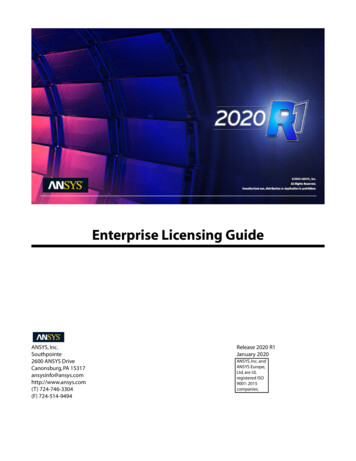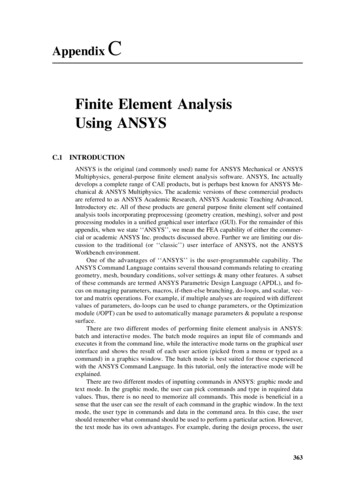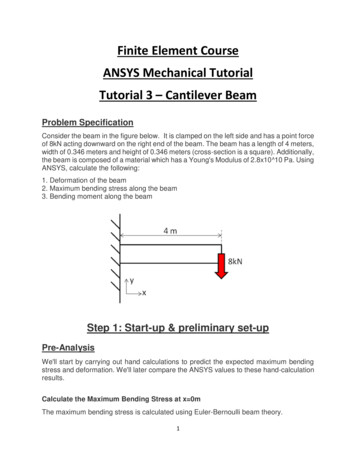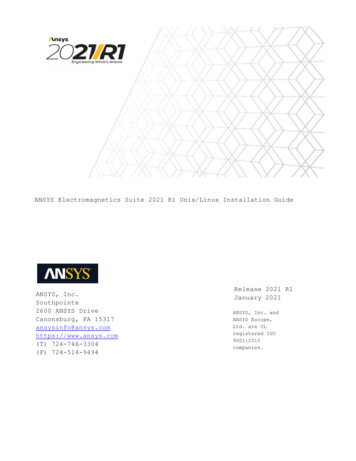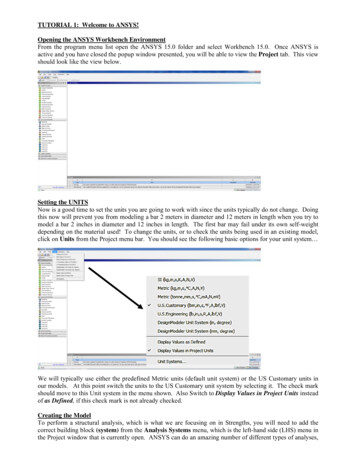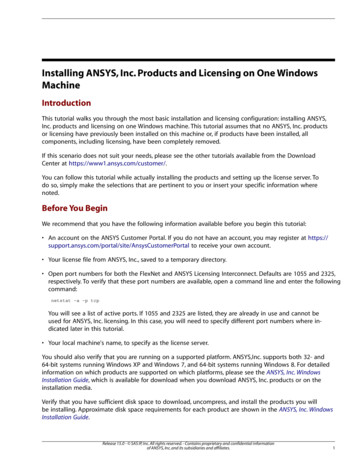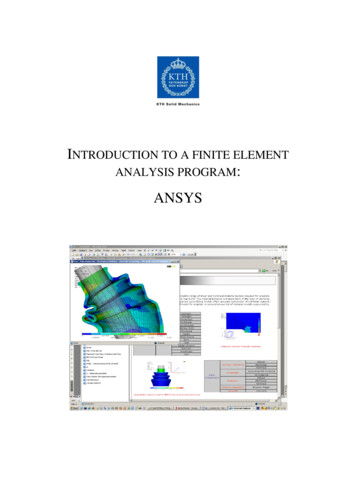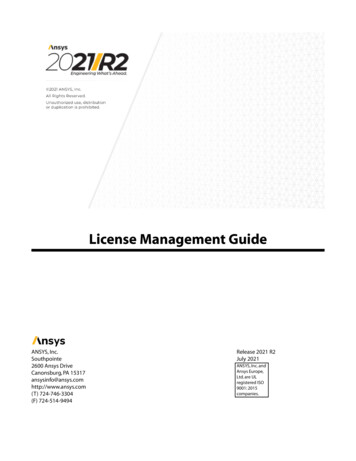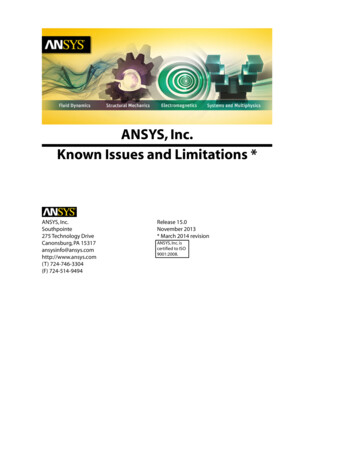
Transcription
ANSYS, Inc.Known Issues and Limitations *ANSYS, Inc.Southpointe275 Technology DriveCanonsburg, PA 15317ansysinfo@ansys.comhttp://www.ansys.com(T) 724-746-3304(F) 724-514-9494Release 15.0November 2013* March 2014 revisionANSYS, Inc. iscertified to ISO9001:2008.
Copyright and Trademark Information 2014 SAS IP, Inc. All rights reserved. Unauthorized use, distribution or duplication isprohibited.ANSYS, ANSYS Workbench, Ansoft, AUTODYN, EKM, Engineering Knowledge Manager,CFX, FLUENT, HFSS, AIM and any and all ANSYS, Inc. brand, product, service and featurenames, logos and slogans are registered trademarks or trademarks of ANSYS, Inc. or itssubsidiaries in the United States or other countries. ICEM CFD is a trademark used byANSYS, Inc. under license. CFX is a trademark of Sony Corporation in Japan. All otherbrand, product, service and feature names or trademarks are the property of their respective owners.Disclaimer NoticeTHIS ANSYS SOFTWARE PRODUCT AND PROGRAM DOCUMENTATION INCLUDE TRADESECRETS AND ARE CONFIDENTIAL AND PROPRIETARY PRODUCTS OF ANSYS, INC., ITSSUBSIDIARIES, OR LICENSORS. The software products and documentation are furnishedby ANSYS, Inc., its subsidiaries, or affiliates under a software license agreement thatcontains provisions concerning non-disclosure, copying, length and nature of use, compliance with exporting laws, warranties, disclaimers, limitations of liability, and remedies,and other provisions. The software products and documentation may be used, disclosed,transferred, or copied only in accordance with the terms and conditions of that softwarelicense agreement.ANSYS, Inc. is certified to ISO 9001:2008.U.S. Government RightsFor U.S. Government users, except as specifically granted by the ANSYS, Inc. software license agreement, the use, duplication, or disclosure by the United States Governmentis subject to restrictions stated in the ANSYS, Inc. software license agreement and FAR12.212 (for non-DOD licenses).Third-Party SoftwareSee the legal information in the product help files for the complete Legal Notice forANSYS proprietary software and third-party software. If you are unable to access theLegal Notice, please contact ANSYS, Inc.Published in the U.S.A.
Table of ContentsRevision History . vIntroduction . vii1. Installation . 12. Licensing . 33. Platform Support . 54. Documentation . 75. Advisories . 96. ANSYS Structural Products . 116.1. Mechanical . 116.2. Mechanical APDL . 136.3. Autodyn . 136.4. Aqwa . 146.5. Beamcheck . 156.6. Fatjack . 157. ANSYS Fluids Products . 177.1. Fluent . 177.2. CFX . 177.3. TurboGrid . 187.4. BladeModeler . 187.5. CFD-Post . 187.6. Polyflow . 188. ANSYS Electronics Products . 198.1. Icepak . 199. ANSYS Geometry & Mesh Prep Products . 219.1. CAD Connections & Integration . 219.2. DesignModeler . 219.3. Meshing . 219.4. IC Engine . 229.5. ICEM CFD . 229.6. Fluent Meshing . 2210. ANSYS Simulation Products . 2510.1. Workbench . 2510.2. EKM . 2610.3. DesignXplorer . 26Release 15.0 - SAS IP, Inc. All rights reserved. - Contains proprietary and confidential information of ANSYS,Inc. and its subsidiaries and affiliates.iii
ivRelease 15.0 - SAS IP, Inc. All rights reserved. - Contains proprietary and confidential information of ANSYS,Inc. and its subsidiaries and affiliates.
Revision HistoryNovember 2013Initial releaseMarch 2014 Updated Documentation (p. 7) and the BladeModeler section inANSYS Fluids Products (p. 17).Release 15.0 - SAS IP, Inc. All rights reserved. - Contains proprietary and confidential information of ANSYS,Inc. and its subsidiaries and affiliates.v
viRelease 15.0 - SAS IP, Inc. All rights reserved. - Contains proprietary and confidential information of ANSYS,Inc. and its subsidiaries and affiliates.
IntroductionThe following information is relevant to ANSYS, Inc. Release 15.0. The entriesdescribe known non-operational behavior, an error, or limitation at the time ofthis release. Work-arounds for these items, if available, are included in the respective descriptions. Inclusion in this document does not imply the issues and limitations are applicable to future releases.The parenthetical numbers associated with each entry are reference numberscorresponding to an internal error tracking system. The numbers are includedto help to facilitate ANSYS, Inc. technical support and help to ensure that theissue described in the entry is resolved.Service packs may become available for some of the entries. See the ANSYSCustomer Portal for information about service packs and any additional itemsnot included in this document. First-time users of the customer portal must register via the ANSYS Web site (www.ansys.com) to create a password.Additional known issues and limitations may be found in the product Help and/orrelease notes, both accessible via the ANSYS Help Viewer within the product.Release 15.0 - SAS IP, Inc. All rights reserved. - Contains proprietary and confidential information of ANSYS,Inc. and its subsidiaries and affiliates.vii
viiiRelease 15.0 - SAS IP, Inc. All rights reserved. - Contains proprietary and confidential information of ANSYS,Inc. and its subsidiaries and affiliates.
Chapter 1: InstallationNo known issues, limitations, or documentation inaccuracies.Release 15.0 - SAS IP, Inc. All rights reserved. - Contains proprietary and confidential information of ANSYS,Inc. and its subsidiaries and affiliates.1
2Release 15.0 - SAS IP, Inc. All rights reserved. - Contains proprietary and confidential information of ANSYS,Inc. and its subsidiaries and affiliates.
Chapter 2: LicensingNo known issues, limitations, or documentation inaccuracies.Release 15.0 - SAS IP, Inc. All rights reserved. - Contains proprietary and confidential information of ANSYS,Inc. and its subsidiaries and affiliates.3
4Release 15.0 - SAS IP, Inc. All rights reserved. - Contains proprietary and confidential information of ANSYS,Inc. and its subsidiaries and affiliates.
Chapter 3: Platform SupportANSYS 15.0 will be the last release to support the Windows XP operating system,Windows 7 (32-bit) operating system, and the Windows 32-bit platform. Subsequent service packs' and verification testing packages' discontinuance of support of Windows XP will concur with Microsoft's discontinuance of the same,anticipated to be April 2014. For detailed and current support information, seethe Platform Support section of the ANSYS, Inc. website (www.ansys.com).Release 15.0 - SAS IP, Inc. All rights reserved. - Contains proprietary and confidential information of ANSYS,Inc. and its subsidiaries and affiliates.5
6Release 15.0 - SAS IP, Inc. All rights reserved. - Contains proprietary and confidential information of ANSYS,Inc. and its subsidiaries and affiliates.
Chapter 4: DocumentationApplicable to all systems in the ANSYS Workbench Toolbox, closing the QuickHelp panel will result in a crash when using the Windows 7 or Windows 8.1 operating system with Internet Explorer 11 installed. Internet Explorer 11 is thedefault for Windows 8.1. (72834)ANSYS Help ViewerWhen using the "Match Case" option of the Help Viewer Search, the results'highlighting incorrectly highlights all matches to the word, regardless of case.(61182)On Windows systems, if you are running from a network installation and theimages do not appear correctly in the Help Viewer, access the shared drivecontaining the installation via a mapped drive instead of accessing the sharedirectly with a UNC path. (70600)ANSYS FluentThe following should be included in the list of limitations for the cluster to clusterbasis in Section 13.3.4.1.2.1. of the ANSYS Fluent 15.0 User's Guide: The cluster-to-cluster basis is not supported for non-conformal interfaces.(71158)CAD IntegrationThe Teamcenter Unified Architecture 9.1 entry in the Geometry Interface Supporttable for Windows in the CAD Integration section inadvertently shows supportfor the Windows 8 operating system. Teamcenter Unified Architecture 9.1 (2- &4-tier) with NX 7.5, NX 8.0, and NX 8.5 is not supported on the Windows 8 operating system. For related issues, see the CAD Connections & Integration sectionof this document. (69423)Release 15.0 - SAS IP, Inc. All rights reserved. - Contains proprietary and confidential information of ANSYS,Inc. and its subsidiaries and affiliates.7
DocumentationThe JT Reader section of CAD Integration help should include the followingstatement in the Caveats and Known Issues section: JT tessellation-only datafiles are not supported. JT Reader requires that the JT file contains BoundaryRepresentation (B-rep) data.EKMIn section 5.1.1.2. Supported Operating System Versions of the EKM InstallationGuide, the list should also include Windows Server 2012. (71010)Section 11.6 Recording Journal Scripts in the EKM Administration Guide containsa list of actions that can be recorded in a journal. The following items in that listshould not be part of the list: Analysis project update analysis Application execute Case model file create summary report File extract metadata File synchronize Lifecycle edit in Studio Recycle bin empty Report refine comparison Script file execute Saved query refine search Workflow edit in Studio(71218)8Release 15.0 - SAS IP, Inc. All rights reserved. - Contains proprietary and confidential information of ANSYS,Inc. and its subsidiaries and affiliates.
Chapter 5: AdvisoriesNo known issues, limitations, or documentation inaccuracies.Release 15.0 - SAS IP, Inc. All rights reserved. - Contains proprietary and confidential information of ANSYS,Inc. and its subsidiaries and affiliates.9
10Release 15.0 - SAS IP, Inc. All rights reserved. - Contains proprietary and confidential information of ANSYS,Inc. and its subsidiaries and affiliates.
Chapter 6: ANSYS Structural Products6.1. MechanicalWhen running a Static or Transient Structural analysis with a Thermal Conditionload, you will need to ensure that all the materials used in the analysis definethe Coefficient of Thermal Expansion property. You cannot proceed to solve youranalysis if this property is not defined, in Engineering Data, for all the materialsused in the analysis. (60429)When scoping results to elements, Mechanical may display and report resultson some elements that were not scoped. This can happen when an unselectedelement has all its nodes in the scoped set. In addition, the reported minimumand maximum values of the result may be incorrect.The reported minimum and maximum values are only correct using elementscoping for the following conditions: Nodal results (like deformations, temperatures, and voltages) Element Nodal results (like stresses, strains, and fluxes) with the Display Optionproperty of the Result object set to Unaveraged.Note: You can determine the data type (Nodal, Element Nodal, or Elemental) ofa result by looking at the Data Type column in the Worksheet of the Solutionobject. (66737)When using parallel part-by-part meshing with extremely large assemblies, youmay see a performance slowdown in remeshing. If you do, a workaround is tosave your project, exit and restart Workbench, reload the project and continuewith your meshing activities. (68906)Element scoping to Coordinate Systems result types (Element Triads, ElementalEuler XY, YZ, and XZ Angle), the Strain Energy result type, or the Error result type,produces invalidate results and may cause Mechanical to crash. These resulttypes currently do not support element-based scoping. In addition, when scopedto elements on the model, you cannot use these result types in combinationRelease 15.0 - SAS IP, Inc. All rights reserved. - Contains proprietary and confidential information of ANSYS,Inc. and its subsidiaries and affiliates.11
ANSYS Structural Productswith the Promote to Named Selection feature; doing so may also cause Mechanical to crash. (69550)When using the Distributed ANSYS solver to perform a fracture analysis inMechanical, the Stress Intensity Factors (SIFS) and J-Integral (JINT) computationsmay yield incorrect results. Mechanical uses the MAPDL CINT,CTNC option witha node not associated with any of the elements as the crack assist node to specifythe crack extension direction. (70326)For 2D analyses on the Linux platform, Mechanical does not support the ImportedInitial Stress and Imported Initial Strain loading option. Specifying and executingthese options causes the application to terminate abnormally. (70647)If you have a Transient Structural analysis and a Modal analysis that share thesame model, and the Transient Structural system includes one or more InitialVelocity objects in the Initial Conditions group, Mechanical will crash if you makechanges to the "Damped", "Solver Type" or "Store Complex Solution" propertiesunder Solver Controls of the Modal system. Work-around: The work-arounddepends upon what you want to achieve. If you want to run independent modal and transient structural solves with thesame model setup and Initial Velocity object(s) present, make sure that theydon't share a common model. Use system "Duplicate" and "Replace with" options from the project schematic to quickly form different analyses with thesame model configuration. If you wish to form a MSUP Transient system by linking a Modal solution toan existing Transient analysis, delete any Initial Velocity objects that are presentin the Transient analysis.(71011)If you experience a failure while importing an external mesh file into Mechanicalvia External Model, you may also encounter large error messages in the Workbench application. These messages can cause Workbench to terminate abnormally.To avoid this error, close the message window in the Workbench applicationbefore importing the data into Mechanical. (71045)For a Pre-stressed Full Harmonic analysis, the Nodal Pressures boundary conditiondoes not support the Function and Tabular features for defining the Magnitudeproperty. If the Magnitude property is set to Function or Tabular, results willappear with a value of zero. (71084)12Release 15.0 - SAS IP, Inc. All rights reserved. - Contains proprietary and confidential information of ANSYS,Inc. and its subsidiaries and affiliates.
AutodynAt Release 15.0 in the Mesh Display section of the Annotation Preferences dialogbox, the "Plot Elements Attached to Named Selections" option is on by default.This causes all the name selections to try to show the underlying mesh, whichin cases with hundreds of name selections and complicated meshes will requiresignificant computing effort, compared with the variant showing the underlyinggeometry. Work-around: In these cases, switch off the "Plot Elements Attachedto Named Selections" option. (71179)6.2. Mechanical APDLFor cyclic mode-superposition harmonic analyses, the POST26 RCYC commanddoes not support equivalent and principal strains and stresses. Work-around:Use POST1 /CYCEXPAND to obtain these quantities. Additionally, the TIMERANGEcommand does not work. Work-around: Use the PLTIME command to limit thefrequency range. (68603)For cyclic mode-superposition harmonic analyses, using the modal coordinatesoutput key (MCout on the HROPT command) leads to incorrect solutions. Workaround: Do not use this option. (68603)For cyclic mode-superposition harmonic analyses, distributed-memory processing(-dis on the command line) is not functioning. Work-around: Use share-memoryprocessing. (63993)When generating superelements with the BACKSUB expansion pass method(SEOPT,BACKSUB), the .LN22 file created by the sparse solver cannot be transferredbetween 32-bit and 64-bit systems. For example, if a superelement is created onthe Windows 64-bit system, it cannot be expanded on a Windows 32-bit system(and vice versa). (70199)In a perturbed harmonic analysis when all the boundary conditions are kept(PERTURB,HARMONIC,,,ALLKEEP), any locked-in pretension load (SLOAD) fromthe preceding prestress step is not ignored and will lead to an oscillating loadin the harmonic analysis. Work-around: Use one of the other LoadControl optionson the PERTURB command which will ignore the locked-in displacement in theharmonic load. (71123)6.3. AutodynIn Euler-Unstructured Langrange coupled models a parallel slave executable mayhang if the decomposition is such that none of the Lagrangian unstructuredelements on that slave participate in the coupling. Work-around: Use theRelease 15.0 - SAS IP, Inc. All rights reserved. - Contains proprietary and confidential information of ANSYS,Inc. and its subsidiaries and affiliates.13
ANSYS Structural Productsmanual decomposition option and decompose the coupled Lagrangian unstructured elements over all the available slaves, such that each slave will participatein the coupling. (69786)For a project containing linked Explicit Dynamics and Autodyn systems, closingWorkbench following an update to the Autodyn system may result in a crash.The termination error can be avoided by closing the Autodyn application beforeWorkbench or saving the project before closing Workbench. No data loss is associated with this issue. (70726)6.4. AqwaIf you are using Design Points in your Aqwa analysis, you may get incorrect resultsif you have duplicate input parameter sets, or if you change or add input parameters or Design Points, then update the Design Points again.After the initial solution, the results displayed in the Table of Design Points onthe Project Schematic are correct. However, if you view the results in the Aqwaeditor, the reported results correctly correspond to the "current" entry in theTable of Design Points, but the displayed values of input parameters are incorrect,so are inconsistent. In addition, if you have two Design Points with identical inputparameters, the results displayed in the Table of Design Points for the secondDesign Point will be incorrect.You must start from a known good state if you want to change or add inputparameters or Design Points. In order to create a known good state, after settingup the initial parameters and Design Points, Archive the project before solving.This allows you to revert back to the known good state whenever you want tochange or add any parameters or Design Points.If you have already run an analysis without archiving the known good state andthen want to change parameters or Design Points, it is necessary to reset all theparameters to their initial values. (This is also true if you resume a project thatyou solved previously and want to make any changes to Design Points or parameters.)To reset the parameters, follow these steps:1. Copy all input parameter values from the Design Point table and paste theminto an external spreadsheet.2. Open the Aqwa editor.14Release 15.0 - SAS IP, Inc. All rights reserved. - Contains proprietary and confidential information of ANSYS,Inc. and its subsidiaries and affiliates.
Fatjacka. Navigate through the tree to each parameterized input.b. Deselect the "parameter" box next to the parameterized input.c. Manually reset the input value to the initial one (the value correspondingto the first Design Point in the Table of Design Points, noted as "Current").d. Reselect the "parameter" box.e. Repeat for all input parameters.3. Optionally close the Aqwa editor4. Go to the Design Points view in the Workbench Project window.a. Copy the information that you saved in the spreadsheet back to theparameters in the Table of Design Points.b. Alternatively, you can reenter all input parameter values by hand.c. Be certain that no Design Points are duplicated.5. At this point you should Archive the project so that you can make changesin the future from the known good state.The project is now reverted back to a known good state allowing the user tosafely click on the "Update All Design Points" button.Remember, once you update the Design Points, the results will be correct in theTable of Design Points, but in the Aqwa Editor, your displayed results will notmatch the input parameter values shown in the editor, and you must revert toyour known good state in order to run a new analysis. (61041)6.5. BeamcheckNo known issues, limitations, or documentation inaccuracies.6.6. FatjackNo known issues, limitations, or documentation inaccuracies.Release 15.0 - SAS IP, Inc. All rights reserved. - Contains proprietary and confidential information of ANSYS,Inc. and its subsidiaries and affiliates.15
16Release 15.0 - SAS IP, Inc. All rights reserved. - Contains proprietary and confidential information of ANSYS,Inc. and its subsidiaries and affiliates.
Chapter 7: ANSYS Fluids Products7.1. FluentSee the Documentation section of this document for items specific to the ANSYSFluent User's Guide.When using poor-mesh-numerics with order 2 on a large number of parallelcores, Fluent may crash if a partition boundary crosses a large cluster of poorcells. Work-around: Re-partition with a different method. (61299)When using the MSMD battery model in distributed parallel, Fluent may crashif a second data file is read into the same Fluent session. (66689)The DEM model is incompatible with periodic boundary conditions and shouldbe avoided. Using this combination may lead to errors or crashes. (69340)When solving System Coupling problems in Workbench, if a Solution Monitoringtab is left open for the connected Fluent session the Fluent processes will notexit when the System Coupling solution is completed. On Windows, this resultsin Workbench remaining in an Updating state until these processes are manuallykilled. On Linux this may lead to Workbench hanging. (69976)Specific to Windows platforms, writing a data file from a parallel Fluent sessionon multiple nodes with the DO radiation model enabled may lead to a crash.This problem does not affect Linux platforms or sessions run on a single node.(70229)7.2. CFXThe "Static and Total Pressure" option for the supersonic inlet boundary conditiondoes not work for variable composition mixtures. The solver will stop with anerror message about missing the initial guess for the Newton iteration method.Please use an alternative option. (69839)Release 15.0 - SAS IP, Inc. All rights reserved. - Contains proprietary and confidential information of ANSYS,Inc. and its subsidiaries and affiliates.17
ANSYS Fluids ProductsThere may be instances where an abort occurs for single precision calculationsfor multiphase flows using multiple frames of reference and the alternate rotationmodel. The floating point exception can be avoided by doing the calculation indouble precision. (70066)Contacts are not read correctly from Meshing when read into CFX-Pre: On connecting a mesh cell to a CFX setup cell or reading a CMDB file directly,if contact has been defined in the upstream component, the contact may notbe read correctly into CFX-Pre with the default settings. Remeshing a casefrom R14.5 or earlier may result in the definition of automatic domain interfacesdependent on the contact not being read correctly. Setting the environment variable CFXACMO IGNORE NON ONE TO ONE CONTACTS or that the ANSYS Meshing ContactDetection preference to Bodies or Self will result all contact being read or detected respectively.(70524)7.3. TurboGridNo known issues, limitations, or documentation inaccuracies.7.4. BladeModelerVia the File Open option, custom file formats (e.g. .rtzt, .mch, .stk) cannot beeasily imported in BladeGen when using the Windows 8.1 operating system. Workaround: Convert the the custom file type by running the converter manually,and then open the resulting native BladeGen file (.bgd). (70578)7.5. CFD-PostNo known issues, limitations, or documentation inaccuracies.7.6. PolyflowPolydata may crash if you click the “Upper level menu” button in the “Remeshingtechnique” menu without first fully defining the selected remeshing technique(that is, defining such settings as the remeshing inlet and outlet for Optimesh,or the g field for Thompson transformation). (70364)18Release 15.0 - SAS IP, Inc. All rights reserved. - Contains proprietary and confidential information of ANSYS,Inc. and its subsidiaries and affiliates.
Chapter 8: ANSYS Electronics Products8.1. IcepakHeat flux and heat flow values at boundary faces of 3D source objects placedinside fluid regions cannot be reported. (36488)The ray tracing radiation model does not include radiative heat transfer for solidsurfaces touching zero slack assemblies. (70293)Release 15.0 - SAS IP, Inc. All rights reserved. - Contains proprietary and confidential information of ANSYS,Inc. and its subsidiaries and affiliates.19
20Release 15.0 - SAS IP, Inc. All rights reserved. - Contains proprietary and confidential information of ANSYS,Inc. and its subsidiaries and affiliates.
Chapter 9: ANSYS Geometry & Mesh Prep Products9.1. CAD Connections & IntegrationSee the Documentation section of this document for items specific to the CADIntegration section of ANSYS Help.An update/refresh may result in unexpected loss of mesh on unmodified bodieswhen a Workbench database from a previous version is resumed in Workbench15.0 and Compare Parts on Update feature is set to Associative. Additionally, ifprogram-controlled inflation is enabled in the meshing settings, it may alsocontribute to an unexpected loss of mesh when refreshing geometry. (68858)ANSYS Workbench may crash when a model imported into Teamcenter UnifiedArchitecture 9.1 (4-tier) is saved more than once, as observed using the Windows8 operating system and Teamcenter patch 9.1.2.3. Teamcenter Unified Architecture9.1 (4-tier) is not supported on the Windows 8 operating system. (69423)CAD Readers for JT, Creo Parametric, Inventor, NX and SolidWorks may not fullyunconfigure on a client of a network installation, even when this action is attempted by a client's administrator. An administrative user on the server must executean unconfigure action, using CAD Configuration Manager, in order for these interfaces to be fully deactivated on the client. (70719)The Allow Model Defeaturing option is known to cause problem for some geometries during Mechanical APDL import. Please avoid using the option if youencounter a problem with it. (70762, 70813, 70818, 70819)9.2. DesignModelerNo known issues, limitations, or documentation inaccuracies.9.3. MeshingParallel Part Meshing will always generate line elements from line bodies, whichmay not be appropriate for an electromagnetic analysis. Work-around: WhenRelease 15.0 - SAS IP, Inc. All rights reserved. - Contains proprietary and confidential information of ANSYS,Inc. and its subsidiaries and affiliates.21
ANSYS Geometry & Mesh Prep Productsmeshing line bodies for an electromagnetic analysis, set the Number of CPUs forParallel Part Meshing under Mesh -- Advanced to 1. (70267)0-thickness
ANSYS, Inc. Known Issues and Limitations * ANSYS, Inc. Release 15.0 Southpointe November 2013 275 Technology Drive * March 2014 revision Canonsburg, PA 15317 ANSYS, Inc. is . First-time users of the customer portal must re-gister via the ANSYS Web site (www.ansys.com) to create a password.
